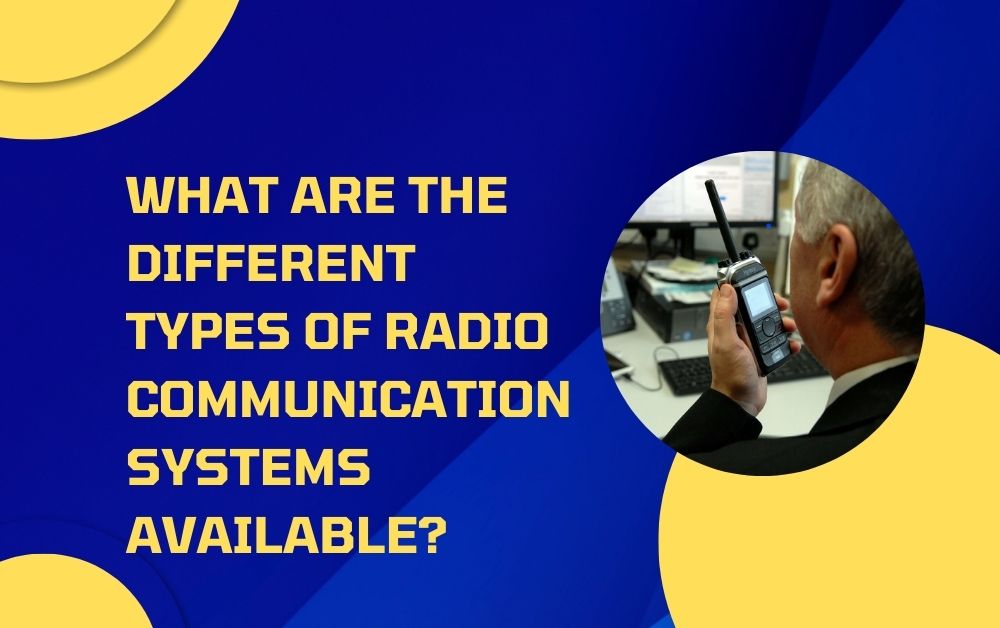Radio communication systems have become an integral part of our daily lives, facilitating seamless communication across various sectors. From emergency services to business operations, these systems play a crucial role in ensuring effective and reliable communication. But what exactly are radio communication systems, and what types are available? This blog will explore the different types of radio communication systems available, their features, and their applications, all in simple and easy-to-understand language.
Understanding Radio Communication Systems
Before diving into the different types, it’s essential to understand what radio communication systems are. At their core, radio communication systems use radio waves to transmit information from one place to another. These systems include a transmitter, which sends the radio waves, and a receiver, which captures and interprets them. The information transmitted can be in the form of voice, data, or even video.
Radio communication systems are widely used because they offer several advantages. They provide real-time communication, can cover vast distances, and are relatively easy to set up and use. Additionally, they are crucial in situations where other forms of communication, like cellular networks, might fail, such as during natural disasters or in remote areas.
Analog Radio Communication Systems
Analog radio communication systems have been around for decades and are one of the most traditional forms of radio communication. These systems transmit voice signals as continuous waves. The main advantage of analog systems is their simplicity and ease of use. They are relatively inexpensive to set up and maintain, making them a popular choice for small businesses, amateur radio operators, and public safety agencies.
However, analog systems do have some limitations. They are more prone to interference and noise, which can affect the clarity of the communication. Additionally, analog systems have a limited capacity for transmitting data, making them less suitable for applications that require high data transfer rates. Despite these drawbacks, analog systems remain widely used due to their reliability and cost-effectiveness.
Addition – Ready to upgrade your communication capabilities? SoyuzTech offers state-of-the-art Radio communication systems designed to meet all your needs. Whether for business, emergency services, or personal use, our expert team ensures you get the best system tailored for you. Contact SoyuzTech today to learn more about our radio communication systems and get a free consultation. Your reliable communication solution starts here!
Digital Radio Communication Systems
Digital radio communication systems are a more modern and advanced form of radio communication. Unlike analog systems, which transmit continuous waves, digital systems convert voice and data into digital signals. This conversion allows for clearer and more reliable communication, as digital signals are less susceptible to interference and noise.
One of the significant advantages of digital systems is their ability to transmit large amounts of data quickly and efficiently. This makes them ideal for applications that require high data transfer rates, such as in business operations, emergency services, and military communications. Digital systems also offer enhanced features, such as encryption for secure communication, text messaging, and GPS tracking.
While digital systems are more advanced, they are also more expensive to set up and maintain. The equipment required for digital communication is typically more costly than that for analog systems. However, the benefits of improved clarity, data transfer capabilities, and additional features often outweigh the higher costs, making digital systems a preferred choice for many organizations.
Two-Way Radio Communication Systems
Two-way radio communication systems, also known as transceivers, are devices that can both transmit and receive radio signals. These systems are commonly used in various applications, including public safety, commercial operations, and recreational activities. Two-way radios are known for their simplicity, reliability, and ease of use.
One of the primary advantages of two-way radios is their ability to provide instant communication. Users can press a button to talk and release it to listen, allowing for real-time, two-way communication. This makes them ideal for situations where quick and efficient communication is crucial, such as in emergency response, construction sites, and event management.
Two-way radios come in various forms, including handheld radios, mobile radios, and base station radios. Handheld radios are portable and convenient, making them suitable for use on the go. Mobile radios are typically installed in vehicles, providing communication while on the move. Base station radios are fixed units used in a central location, such as an office or command center, to coordinate communication.

Trunked Radio Communication Systems
Trunked radio communication systems are a more complex and efficient type of radio communication. These systems use a computer-controlled network to manage multiple radio channels. Trunked systems allocate available channels to users as needed, optimizing the use of the radio spectrum and ensuring efficient communication.
The main advantage of trunked systems is their ability to handle a large volume of communication traffic. This makes them ideal for organizations with many users, such as public safety agencies, large businesses, and government entities. Trunked systems also offer enhanced features, such as priority access for critical users, interoperability with other communication systems, and the ability to integrate voice and data communication.
While trunked systems offer significant benefits, they are also more complex and expensive to implement and maintain. The infrastructure required for trunked communication is more advanced, and the system needs regular monitoring and management. Despite these challenges, the efficiency and capabilities of trunked systems make them a valuable choice for organizations with high communication demands.
Satellite Radio Communication Systems
Satellite radio communication systems use satellites orbiting the Earth to transmit radio signals. These systems provide global coverage, making them ideal for communication in remote and hard-to-reach areas where traditional radio communication systems might not be effective.
One of the primary advantages of satellite systems is their ability to provide communication in areas with no infrastructure. This makes them invaluable for disaster response, maritime communication, and remote expeditions. Satellite systems also offer high data transfer rates, allowing for the transmission of voice, data, and video.
However, satellite systems are typically more expensive than other types of radio communication systems. The cost of satellite equipment and the need for satellite service subscriptions can be significant. Additionally, satellite communication can be affected by weather conditions and requires a clear line of sight to the satellite. Despite these challenges, the benefits of global coverage and high data transfer capabilities make satellite systems an essential tool for many applications.
Internet Protocol (IP) Radio Communication Systems
Internet Protocol (IP) radio communication systems use the internet to transmit radio signals. These systems convert radio signals into digital data and transmit them over an IP network. IP radio systems offer several advantages, including the ability to integrate with existing IT infrastructure, scalability, and enhanced features such as data encryption and remote management.
One of the significant benefits of IP radio systems is their ability to provide seamless communication over long distances. By using the internet as a transmission medium, IP radio systems can connect users in different locations, enabling global communication. This makes them ideal for businesses with multiple offices, remote workers, and organizations with international operations.
IP radio systems also offer enhanced features, such as the ability to integrate with other communication systems, including phone systems and computer networks. This integration allows for a unified communication platform, improving efficiency and collaboration. Additionally, IP radio systems can be managed remotely, providing greater flexibility and control.
While IP radio systems offer significant benefits, they also require a reliable internet connection and may be more complex to set up and maintain. The cost of IP radio equipment and the need for IT expertise can also be a consideration. However, the advantages of seamless global communication, integration with existing infrastructure, and enhanced features make IP radio systems a valuable choice for many organizations.
Conclusion
In conclusion, there are various types of radio communication systems available, each with its own advantages and applications. Analog systems offer simplicity and cost-effectiveness, while digital systems provide enhanced clarity and data transfer capabilities. Two-way radios offer instant communication, and trunked systems provide efficient management of multiple channels. Satellite systems offer global coverage, and IP radio systems provide seamless communication over long distances.
When choosing a radio communication system, it’s essential to consider your specific needs, budget, and the features required. By understanding the different types of radio communication systems available, you can make an informed decision and select the best system for your application. Whether you’re enhancing communication for public safety, business operations, or personal use, the right radio communication system can provide reliable and effective communication, improving efficiency and safety.
For more insightful articles related to this topic, feel free to visit thataiblog.com




